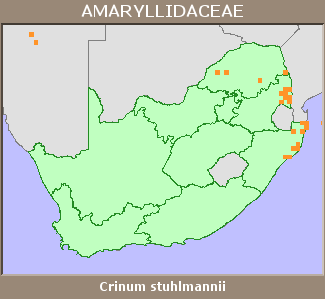|
Scientific Name | Crinum stuhlmannii Baker |
Higher Classification | Monocotyledons |
Family | AMARYLLIDACEAE |
Synonyms | Crinum delagoense I.Verd., Crinum forbesii (Lindl.) Schult. & J.H.Schult. (in part) |
National Status |
Status and Criteria | Least Concern |
Assessment Date | 2016/06/28 |
Assessor(s) | V.L. Williams, D. Raimondo, N.R. Crouch, A.B. Cunningham, C.R. Scott-Shaw, M. Lötter, A.M. Ngwenya & V.J. Brueton |
Justification | Despite the widespread distribution, some population decline is likely because very big, old bulbs are being harvested and sold in medicinal plant markets. However, it can still be seen in a number of localities, and current levels of decline are unlikely to exceed 10% of the population. |
Distribution |
Endemism | Not endemic to South Africa |
Provincial distribution | KwaZulu-Natal, Limpopo, Mpumalanga |
Range | KwaZulu-Natal, Mpumalanga, Limpopo, Swaziland and Mozambique. |
Habitat and Ecology |
Major system | Terrestrial |
Major habitats | Indian Ocean Coastal Belt, Savanna |
Description | Scattered in grassland, bushveld and on sandy soils at low altitudes, in deep sand in lowveld bushveld. |
Threats |
| Crinum spp. is threatened by harvesting for the medicinal plant trade. It is difficult to tell the species apart without flowering material, and the users and market traders do not distinguish between the species, hence they are all at risk of over-exploitation. The species most commonly found in the markets are Crinum bulbispermum, C. stuhlmannii, C. macowanii and C. moorei - the latter species being the most vulnerable due to its smaller distribution and possibly the most distinctive because of the neck that forms a false stem (Verdoorn 1973). Cunningham (1988) estimated that 122 bags of Crinum spp. (excluding C. bulbispermum) were sold between 54 traders in the Durban markets. Its vulnerability status was classed as 'indeterminate' i.e. it appears to be heavily exploited, but its vulnerability to harvesting is unknown and more data are required (Cunningham 1988). Williams (2007) recorded that the species occurred in 28% of muthi shops in Johannesburg in 1994, and was sold by 9% of the traders at the Faraday Street muthi market. The bulbs are usually very large (usually >10cm diameter) and very heavy, and are sold in moderate quantities throughout the market.
Of Crinum stuhlmannii, they may be the most prevalent of the Crinum species in the market based on bulbs that were bought from the Faraday muthi market and brought back to the greenhouse to flower (V.J. Brueton, pers. comm., 2008). The bulbs are generally very large, often have sand around the base and cost R50-R60 for one bulb (by comparison, one can usually purchase several bulbs of other species for R10-R20). One trader in the market recently said that the bulbs he sold had come from Mangusi near Kosi Bay - this corroborated the presence of very sand soil adhering to the bulb.
The bulbs are very slow growing and old and tend to be found in clusters of 3-4 bulbs. Population decline is likely because very big, old bulbs are being harvested and sold in the market (average size 13.6±5.9cm, pers. comm. V.J. Brueton 2008). Still be seen in some places, and it appears to be protected in the Kruger National Park.
The extent to which C. stuhlmannii is affected by the amaryllis caterpillar is not known. |
Population |
Population trend | Decreasing |
Assessment History |
Taxon assessed |
Status and Criteria |
Citation/Red List version | | Crinum stuhlmannii Baker | Declining | Raimondo et al. (2009) | |
Bibliography |
Cunningham, A.B. 1988. An investigation of the herbal medicine trade in Natal/KwaZulu. Investigational Report No. 29. Institute of Natural Resources, Pietermaritzburg.
Raimondo, D., von Staden, L., Foden, W., Victor, J.E., Helme, N.A., Turner, R.C., Kamundi, D.A. and Manyama, P.A. 2009. Red List of South African Plants. Strelitzia 25. South African National Biodiversity Institute, Pretoria.
Verdoorn, I.C. 1973. The genus Crinum in Southern Africa. Bothalia 11:27-52.
Williams, V.L. 2007. The design of a risk assessment model to determine the impact of the herbal medicine trade on the Witwatersrand on resources of indigenous plant species. Unpublished PhD Thesis, University of the Witwatersrand, Johannesburg.
|
Citation |
| Williams, V.L., Raimondo, D., Crouch, N.R., Cunningham, A.B., Scott-Shaw, C.R., Lötter, M., Ngwenya, A.M. & Brueton, V.J. 2016. Crinum stuhlmannii Baker. National Assessment: Red List of South African Plants version 2024.1. Accessed on 2025/11/23 |
 Comment on this assessment
Comment on this assessment


